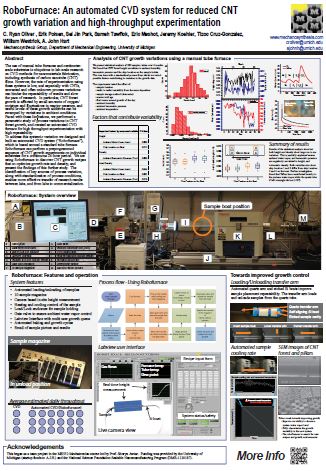I attended the Materials Research Society conference in Boston this year. This conference is one of the largest in the country with thousands of attendees. The society according to their website:
“The Materials Research Society (MRS) was established in 1973 by a visionary group of scientists who shared the belief that their professional interests were broader in scope than existing single-discipline societies and that a new interdisciplinary organization was needed. Today MRS is a growing, vibrant member-driven organization of over 16,000 materials researchers from academia, industry, and government, and a recognized leader in the advancement of interdisciplinary materials research. Headquartered in Warrendale, Pennsylvania (USA), MRS membership now spans over 80 countries. ”
I presented a poster entitled “Robofurnace: An automated CVD system for reduced CNT growth variation and high-throughput experimentation.”
Abstract
The use of manual tube furnaces and centimeterscale substrates is ubiquitous in lab-scale research on CVD methods for nanomaterials fabrication, including synthesis of carbon nanotube (CNT) films. However, the rate of experimentation using these systems is low, and especially with CNTs, unwanted and often unknown process variations can hinder the repeatability of results and slow the pace of research. In particular, CNT forest growth is affected by small amounts of oxygen/moisture and fluctuations in reactor pressure, and useful levels of these growth additives can be swamped by variations in ambient conditions. Faced with these limitations, we performed a
parametric study of process variations in CNT forest growth, and created an automated CVD furnace for high throughput experimentation with high repeatability. To address this systemic variation we designed and built an automated CVD system (“Robofurnace”), which is based around a standard tube furnace. Robofurnace can perform a preprogrammed sequence of CNT growth experiments on individual substrates for a continuous 24-hour period. We are using Robofurnace to discover CNT growth recipes that co-optimize growth rate and density, and present the findings of this further study. The identification of key sources of process variation, along with standardization of process conditions, enables more effective transfer of research results between labs, and from labs to commercialization.






